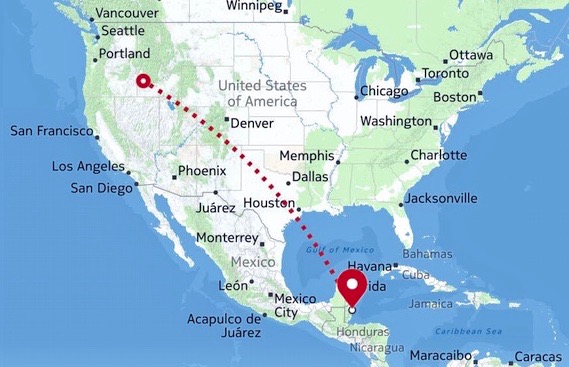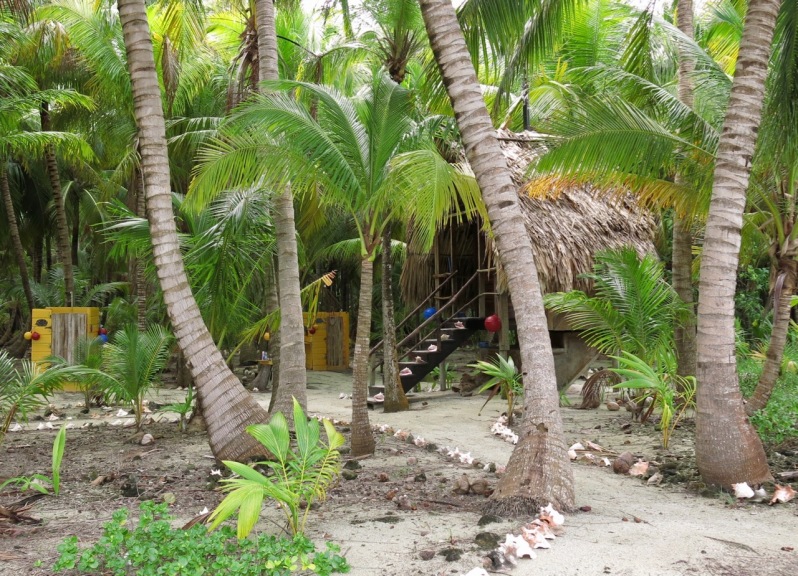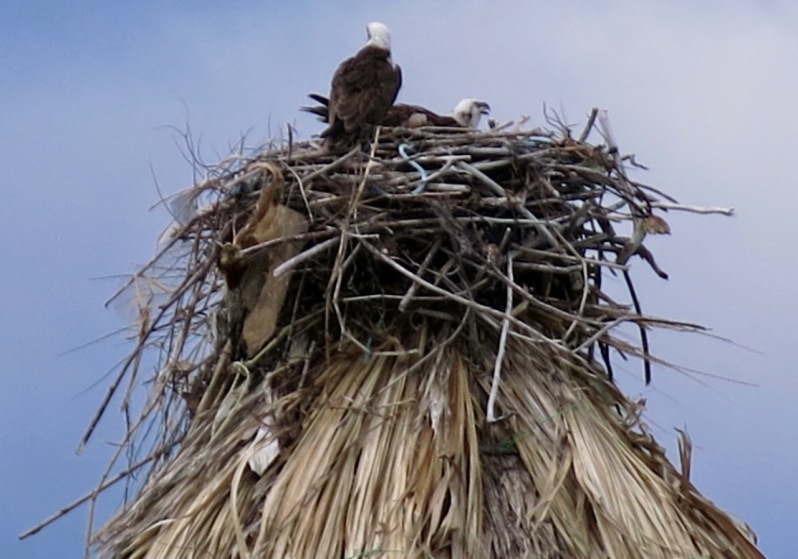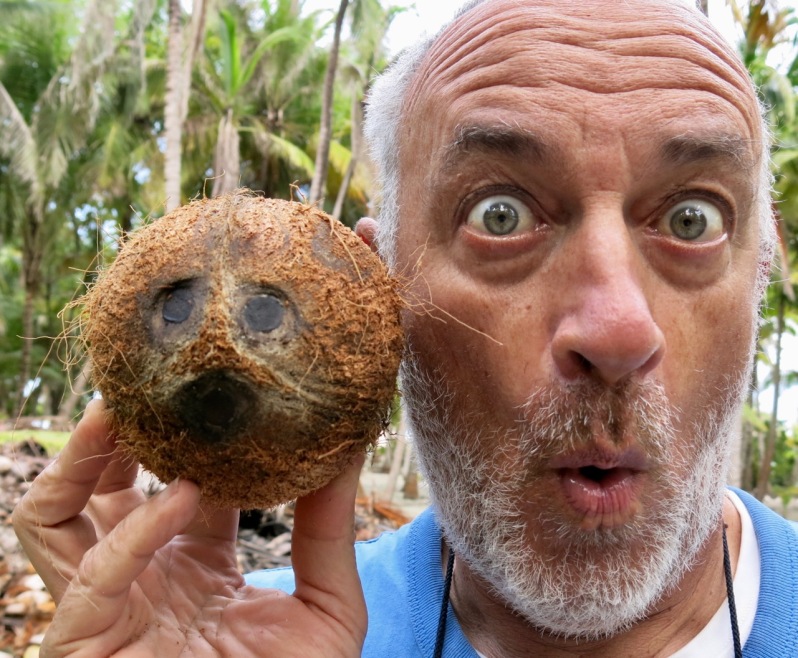Central America – Part 1

The suggested Google Maps route to drive Moby to Belize.

We flew instead. Moby stayed home.

Belize is one of those little Central American countries that few Americans could find on an unlabeled map. We planned a three week stay there.

We flew into Belize City, made it to Hopkins via local buses and hitchhiking, and took it easy in the village there for 5 days. Then we took a boat 35 miles offshore to Glover’s Atoll. It is named after English pirate brothers John and Roger Glover who, in the 1750’s, used the reefs as a base to raid Spanish treasure galleons. They were some of the original pirates of the Caribbean.

Glover’s Atoll is a 50 mile ring of coral reefs. There are four Gilligan’s Isle-sized islands on the SE corner, each with trees and developments. At low tide perhaps 90% of the ring is exposed and walkable, albeit a very rough and slow walk on a jumble of coral chunks.

Glover’s Atoll Resort is definitely at the low end of the spectrum when it comes to creature comforts and guest services. It is also at the bottom of the price range. It has had, shall we say, mixed reviews online. But some good friends had been there twice and said not to worry. They were right. If you are used to taking care of yourself and you view it as a camping trip, it is a fine place. If you are expecting five star services and need to be pampered, then stay away. The fact that most of the 15 or so guests during our week there were repeat customers, some who had been coming for decades, says a lot. Most were here for scuba diving.
Few of the guest were Americans. In my experience the vast majority of Americans like their foreign travel sanitized. Americans like canned tours with a bunch of other Americans. No matter the country, the resorts Americans choose all look about the same. They prefer secure islands, gated compounds, and touristified communities where the only locals they meet are service employees. Better yet, Americans love to take cruises where they get off the ship for a few hours a day and then can say they have “done” this country or that one without actually having slept there. There are plenty of foreign tourists who get off the beaten path, but the vast majority seem to be Germans, Brits, assorted western Europeans, and Aussies. When it comes to really experiencing foreign lands, Americans are pathetic. Once a week this catamaran makes the trip out to Glover’s Atoll Resort. While you can buy meals there, many guests took the cheap option like we did, which means you have to bring all your own food.
Once a week this catamaran makes the trip out to Glover’s Atoll Resort. While you can buy meals there, many guests took the cheap option like we did, which means you have to bring all your own food.

On our way to Glover’s, we cruised five miles down the Sittee River. It reminded me of that 1986 Harrison Ford movie, The Mosquito Coast, which was filmed in Belize. There were squawking jungle birds, crocodiles lurking in the water, and big green iguanas lounging in the trees,

We broke out into salt water but were still protected by offshore reefs and islands.

Pirate brothers John and Roger would be amazed at how things have changed in their old neighborhood. Virtually every island with at least a few trees and a bit of sand has been developed. Fantasy islands one and all.

Want a fantasy island of your own? These folks can help you find one.

Located on the southernmost tip of Glover’s Atoll, Manta Caye is for sale.

Only $5.5 Million. Seems like a good deal to me. Just raid a few treasure ships and you can afford it.

Finally we arrived at our island, on the edge of the deepwater ocean.


Flip flops and shorts was my planned wardrobe for the entire week.

The huts come furnished with rainforest hardwood furniture. Such hardwoods are of course water and rot resistant. Which is good because when it rains and the wind blows, the rustic walls and storm-torn roofing allow in plenty of water.

Cold water showers (cold water trickles really) and a two story composting toilet are shared by all guests.

No safety railings here.

The master chef at work in the state-of-the-art kitchen. Janene took a vow not to cook for the entire week.


Ocean critters swam under our deck

No, I did not take this photo. Any underwater shots in this blog are the work of someone else.

One hut had an osprey nest on top.

We watched them feed their babies all week.

Day 1 was fine for snorkeling, but Day 2 grew dark and stormy.

Too cold for swimming, I decided to try the fishing.

The bonefish is revered in fly fishing circles. There is practically a religion built up around them. Scores of books and hundreds of articles have been written about the art of their pursuit. They are legendary in their wariness and difficulty to catch. Bonefish are famously alert and wary and easily spooked. All my life I have have heard this hype.

It took me all of four casts to hook my first bonefish.

Pound for pound bonefish are tremendous fighters.

They are suckers for flies that imitate little crabs. .

But they are safe from ending up on our menu. Besides being chock full of bones (who would have thought, with a name like bonefish?) they sometimes build up toxins leading to ciguatera poisoning if eaten.

Why did I find it so easy to catch bonefish? Did I have some secret technique? Perhaps I am some sort of really smart, stable genius. Will I rock the bonefishing world with profound new insights? No. The key is that no one fishes for them here. Everyone comes here to scuba dive, snorkel, or just hang on a tropical beach. My approach was to wait until a massive school of bonefish came near the dock, then cast beyond them and drag my my fly through the middle. There were so many fish so tightly packed that my line would vibrate from so many fish swimming into it.

Janene’s travel-size ukulele was a perfect match for the Caribbean water color . . .

. . . at least until Day 3 when the howling rains kicked in . . .
. . . and Day 4 . . . and Day 5. But we counted our blessings. Unlike many of our neighbors, our thatched roof did not leak directly over the bed.

So we hunkered down and did a lot of reading. . . . .

. . . and meditation. Having no ice for drinks might reduce a lesser man to tears, but I made it through with the occasional lukewarm beer. And rum shots. I know how to survive in the wilderness.

The island dogs were a fuzzy lot.

This guy’s gene pool is a little short on pigment.

One day between storms we we broke out of the cabin for a few hours and took a walk north on the reef at low tide.

While snorkeling here we had seen a number of barracuda. I hoped to entice one with the my fishing rod, but no such luck.

I tried to convince Janene to swim out, snorkel around, and point out the barracuda to me, so I would know where to cast. Despite the fact that barracuda almost never attack humans, she demurred.

Day 6 was still unseasonably cold, but our time was running out. So we took a kayak a few miles up the reef to do some snorkeling and fishing. Even with a wetsuit top it was chilly in the water. Too chilly for Janene for sure.

Decidedly too chilly considering that there wasn’t much to see. Sadly, most of the corals here in the shallow water reef area are dead, a victim of warming oceans. The scuba divers said the coral in the deeper cooler waters are still ok, but I would not recommend coming here to just for snorkeling. It was pretty bleak.

But I did swim up on several several big Southern Stingrays. The water was cloudy due to all the recent winds, so I got pretty close before noticing them. It was really cool, so I would slowly get closer and closer until I realized they weren’t afraid of me. Then I began to wonder if I should be afraid of them. What the hell do I know about stingrays? I backed off and gave them some space.

Pronounced “conk”, as in “I’m gonna conk you on the head.” One memory I have from my grandma’s house as a kid was a conch shell she had. I was fascinated by its size, color and funky shape.

Within two miles of the resort, there is a no harvest zone for fish or any other critters. But beyond this preserve, conch can be found on the reef and brought back to fry up for dinner. Only the big ones can be harvested. I started out looking for bright pink shells. But I soon discovered that conch in the wild have a heavy coating of algae and seaweed. They carry their own onboard ecosystem.

I spotted a few big conch inside the no-harvest preserve but none in the harvest zone. No conch fritters for us. Others have clearly found them though. We found huge piles of conch shells left behind by greedy harvesters.

Bleached corals, plastics galore and overharvested conch. Not exactly an uplifting snorkeling experience here at the eco resort. The seashores of Belize are depressingly awash in plastics.

But there were plenty of coconuts.

A steel stake in the sand is used to remove the outer husk.

It was a bit of a battle on the first few to figure out how to get the husk off.


Put the monkey face in your palm, then whack the other end with the dull side of a machete.

Presto!

Fresh, organic, local coconut water.

Nurse sharks regularly patrolled the boat dock.

This was because they knew that the staff would clean fish here to serve to dinner guests. Nurse sharks don’t harm people, but it still seemed bold to stand in the water filleting fish with a shark feeding frenzy going on just a couple feet away.

For Janene it was a brave move to get her toes so close to the action.

Wouldn’t you know it, on our last evening on the island the winds died down, and the warm sun came out of hiding at last.

Belikin is the national beer of Belize. They have a good work/life balance in this country. “You better Belize it” they say.

It may not have been an ideal vacation week, but it beat most every work week in my life.

That is not atoll what I expected to see of Belize. But I enjoyed seeing another retired couple’s slap in the face of the working man. I believe I was concurrently struggling with comma-splices and non-coordinate adjectives, a brutal combination.
I was surprised to find nary a toll road on the island. Think of it as not a slap in the face but as beacon of inspiration and a glimpse of a future without comma-splices or non-coordinate adjectives.
I’ll keep the Moby route in mind when I drive down 🙂 but I’ll be zigzagging more – Baja first. Thanks for sharing Larry and Janene!
I do want to Belize what you experienced there. Thanks for sharing, Larry & Janene.